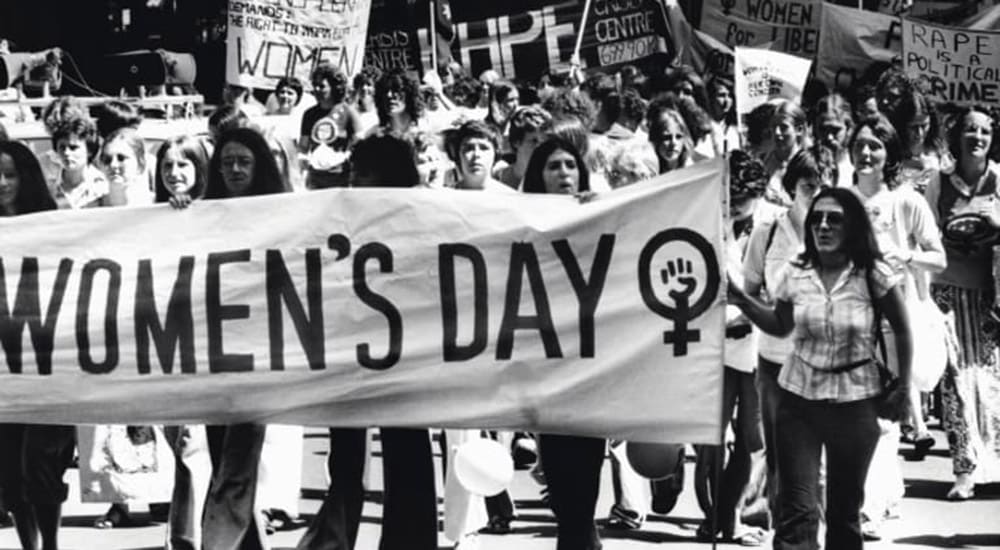International Women’s Day is widely recognized today as a global celebration of women’s rights and achievements, but the origins of the holiday are actually much more radical and nuanced. In fact, the concept was born as both a labor movement and a push for women’s suffrage. The idea of a day celebrating women was first conceived by New York socialists in 1909 as a way to champion women’s rights and commemorate the city’s garment workers’ strike. On February 28, the first National Woman’s Day was observed, with celebrations in both Brooklyn and Manhattan. At the Brooklyn labor meeting, novelist Charlotte Perkins Gilman said, “It is true that a woman’s duty is centered in her home and motherhood, [but] home should mean the whole country and not be confined to three or four rooms or a city or a state.”
READ: Backlash: Women’s History Month in a Post-Roe World
It wasn’t until the following year, however, that the concept of a “woman’s day” become prominent across Europe. At the Second International Conference of Socialist Women in Copenhagen in 1910, Clara Zetkin, a German socialist and women’s activist, proposed a holiday recognizing the role of women in the international socialist movement. Zetkin was a staunch opponent of “bourgeouis feminism,” which she said focused more on gender than class. According to Kristen R. Ghodsee, a professor of Russian and Eastern European studies at the University of Pennsylvania, the word feminism “was associated with bourgeois women in England who were trying to get the right to vote and own property and didn’t really care about women in the working class.”
During the conference, the resolution to celebrate an annual women’s day was passed, declaring that “socialist women of all nationalities have to organize a special Women’s Day, which must, above all, promote the propaganda of female suffrage” in accordance with the class-conscious, socialist conception. The following year, Germany, Austria, Denmark, and Switzerland celebrated International Women’s Day, with more than 1 million people attending rallies and marches in honor of the new holiday. “It was very much associated at that time with European social democracy and democratic socialist parties,” Ghodsee told the Bucks County Beacon.
In the years that followed, the holiday was used to protest various causes impacting working women and even became an important day for pacifist and anti-war activism during World War I. But International Women’s Day wasn’t actually celebrated on March 8 until 1917, when women threw massive protests in Russia. “Women, for Women’s Day, went out in the street and basically started protesting against the czar and against World War I, and they were specifically asking for better rations for veterans coming back from the war and higher disability pensions for men who had been maimed in the war or for widows and orphans of men who had died,”Ghodsee said. “That event, which is often called the February Revolution, is what led to the abdication of the czar and eventually to Russia’s withdrawal from World War I.”

The 8-day demonstration is known as the February Revolution because Czarist Russia followed the Julian calendar at the time, which is 13 days behind the more popular Gregorian calendar, making International Women’s Day February 23 in Russia and March 8 in the West. This date was finalized in 1921 at the International Communist Women’s Congress, which was chaired by Zetkin, and has remained the same ever since. More than 50 years later, in 1975, the United Nations officially recognized March 8 as International Women’s Day and observed the holiday as a celebration of women’s achievements.
As the holiday has become mainstream, however, Ghodsee says it has grown further away from its “socialist roots,” adding that while it is now celebrated all over the world, International Women’s Day has “lost any association with its radical past.”
If the holiday were to be celebrated as it was intended, she notes, “it would be a day where we actually talked about issues that are still affecting women,” including the overturning of Roe v. Wade, Alabama’s IVF ruling, sexual harassment, the gender pay gap, and the lack of paid parental leave. “There are lots of issues that women still face in our country and March 8 could be a day where we raise awareness about those issues,” Ghodsee added.







